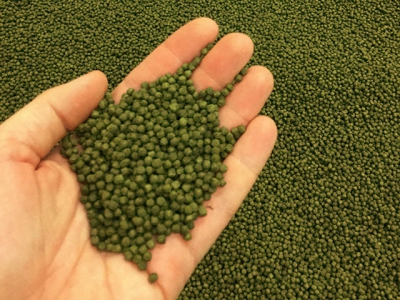Could a forage crop replace forage fish in aquafeeds?

Feed pellets made from the protein-rich leave of alfalfa are proving popular in feed trials currently being conducted in the US.
Alfalfa has many benefits over other crops commonly used in aquafeeds, including the fact that it fixes nitrogren from the atmosphere into the soil. Photo: USDA
Alfalfa – which is the third largest arable crop in the US – is traditionally fed to livestock, including cattle and horses, but a study currently being undertaken by the US Agricultural Research Service (ARS).
They're experimenting with alfalfa as part of a broader effort to find suitable alternatives to using fishmeal. Aquaculture is the fastest-growing sector of the food industry worldwide, generating $1.37 billion in US sales alone. However, there's concern that increasing consumer demand for aquaculture products will outpace what the ocean's wild-caught stock of sardine, anchovy, menhaden and other small forage fish can supply as a fishmeal resource for aquafeeds.
According to Deborah Samac, who leads the ARS Plant Science Research Unit in St Paul, Minnesota, formulating aquafeeds with plant-based proteins could help lessen the need for fishmeal in aquafeeds, reducing aquaculture's impact on aquatic natural resources. Using nutritious, affordable alternatives to fishmeal could also ease the burden on pelagic fish populations.
Soybean meal, barley and algae are among alternatives being explored or already commercialised. And alfalfa is a promising candidate as it contains a crude protein content of 15 to 22 percent and a rich assortment of vitamins, including A, B and D, as well as minerals such as magnesium and copper.
ARS feeding trials with yellow perch may foretell of an alfalfa-based aquafeed's future as a sustainable alternative to using fishmeal.
Alfalfa is typically fed to dairy cows, beef cattle and horses as hay, silage or a direct forage. But it can also be "juiced" for its protein concentrate, and that's the form Samac and her University of Minnesota (UM) collaborators used for their yellow perch feeding trials.
The actual formulation process can involve passing alfalfa leaves through a screw press, squeezing out juices and then heating and centrifuging them to produce a protein concentrate, which is then dried and processed into small pellets along with other ingredients.
The feeding trial results showed that perch given pellets containing the alfalfa protein concentrate (APC) gained somewhat less weight than perch given fishmeal formulations. But there was little difference between their health, longevity and overall wellbeing. Their fillet yields, quality, composition and flavour were also similar.
According to Samac, alfalfa could help impart greater sustainability to the $133.5 billion global aquafeed market by virtue of the ecosystem services and other benefits the crop provides.
As a legume, it naturally converts atmospheric nitrogen into a form that corn and other crops can use for their growth, alleviating the need to apply chemical fertilisers. Alfalfa's robust growth makes it an ideal cover crop, anchoring soil, retaining its moisture, helping it store carbon and controlling weeds. Alfalfa flowers are also important food for both wild and domesticated bees, contributing to the latter's production of honey, wax and other products.
Samac said additional studies are underway to fine-tune the APC concentrations used in aquafeed formulations, evaluate different processing methods, and expand feeding trials to species including rainbow trout. Value-added uses for byproducts of the APC juicing process will also be explored, she added.
Related news
 What's the minimum light level needed in salmon RAS?
What's the minimum light level needed in salmon RAS? Research into how LED light levels in closed-containment recirculation aquaculture systems (RAS) impact the physiology of salmon is the subject of a new study
 Ensuring the right light for RAS production
Ensuring the right light for RAS production Surprisingly little research into establishing the optimal lighting conditions for salmon in RAS facilities has been published.
 Why floating closed containment aquaculture could be dead in the water
Why floating closed containment aquaculture could be dead in the water The dream of operating floating closed containment aquaculture systems at sea is at risk of becoming “a dead case” in Norway, due to regulatory constraints.